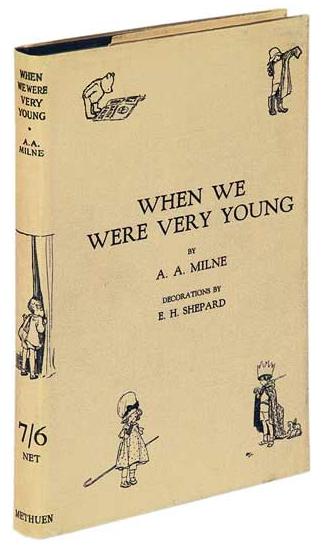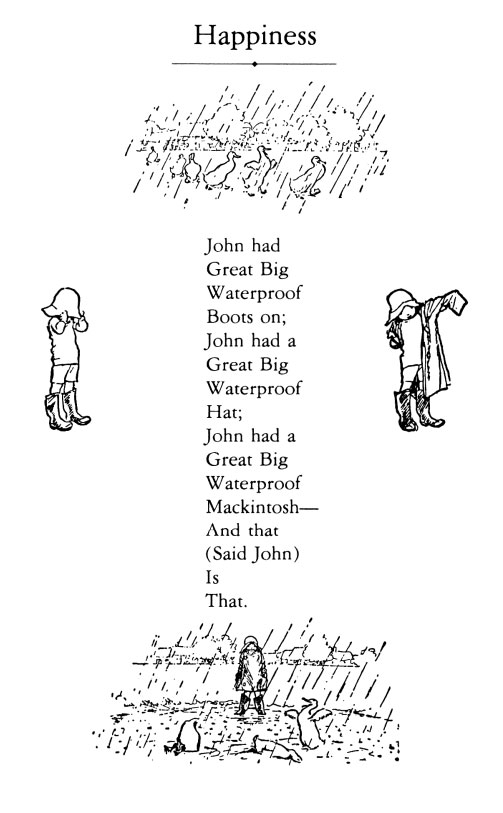
Saturday, January 21, 2012
Reason #6795 to love Durham - lard can be an impulse buy - at Old Havana

Thursday, January 19, 2012
Every time it snows in a big city

Every time it snows in a big city everyone is having the exact same conversation
ViewBulls to Host 2012 Hospitality Team Job Fair
Wednesday, January 18, 2012
Happy 130th Birthday, A. A. Milne: “Happiness” and the Origin of Winnie-the-Pooh
On rainy days and the simplicity of happiness.
 One hundred and thirty years ago today, Alex Alexander Milne (1882-1956) took his first breath. Best known for authoring the Winnie-the-Pooh book series, among the most beloved children’s books with timeless philosophy for grown-ups, A. A. Milne was also a prolific poet. In 1924, two years before the first Winnie-the-Pooh book, he penned When We Were Very Young — a collection of poetry for young children, illustrated by E. H. Shepard. In the 38th poem of the book, titled “Teddy Bear”, the famed Winnie-the-Pooh character makes his first appearance. Originally named “Mr. Edward Bear” by Christopher Robin Milne, Milne’s own son, Winnie-the-Pooh is depicted wearing a shirt that was later colored red for a recording produced by Stephen Slesinger, an image that eventually shaped the familiar Disney character.
One hundred and thirty years ago today, Alex Alexander Milne (1882-1956) took his first breath. Best known for authoring the Winnie-the-Pooh book series, among the most beloved children’s books with timeless philosophy for grown-ups, A. A. Milne was also a prolific poet. In 1924, two years before the first Winnie-the-Pooh book, he penned When We Were Very Young — a collection of poetry for young children, illustrated by E. H. Shepard. In the 38th poem of the book, titled “Teddy Bear”, the famed Winnie-the-Pooh character makes his first appearance. Originally named “Mr. Edward Bear” by Christopher Robin Milne, Milne’s own son, Winnie-the-Pooh is depicted wearing a shirt that was later colored red for a recording produced by Stephen Slesinger, an image that eventually shaped the familiar Disney character.
The third poem in the book is a short gem titled “Happiness” — a wonderful meditation on how little it takes to find happiness. (And, clearly, a giant missed opportunity for Apple.)
John had
Great Big
Waterproof
Boots on;
John had a
Great Big
Waterproof
Hat;
John had a
Great Big
Waterproof
Mackintosh–
And that
(Said John)
Is
That.
 Brain Pickings has a free weekly newsletter and people say it’s cool. It comes out on Sundays and offers the week’s best articles. Here’s what to expect. Like? Sign up.
Brain Pickings has a free weekly newsletter and people say it’s cool. It comes out on Sundays and offers the week’s best articles. Here’s what to expect. Like? Sign up.
Brain Pickings takes 450+ hours a month to curate and edit across the different platforms, and keeping it ad-free isn't easy. If it brings you any joy and inspiration, please consider a modest donation – it lets me know I'm doing something right.
Tuesday, January 17, 2012
Monday, January 16, 2012
Time Lords Want to Ditch the Sun

The International Telecommunication Union will decide this week not only whether there’ll be an extra leap second in June, but whether it will be the last of its kind. The decision could mean that we no longer take any notice of the Sun when it comes to determining time.
As we’ve previously covered, the leap second is necessitated by the way we currently measure time — simply observing the Earth’s movement round the Sun and dividing by the relevant fractions — which is inherently flawed. That’s because the Earth is slowly moving away from the Sun, thus increasing its orbit time.
While the leap year deals with the fact that the time of the orbit doesn’t precisely divide into 365 days, the leap second deals with the disparity between the solar second and the time measured on atomic clocks, which take the time from vibrations in cesium and thus aren’t affected by the slowing orbit time. That’s important as such clocks are ultimately used to inform most computer systems.
Each June 30th and December 31st, depending on the disparity, officials will have decided whether to add an artificial leap second to the atomic clocks. As a result the solar and atomic clocks are never more than a second out. (Unfortunately the leap second does occasionally cause systems to freak out, for example if they’ve been programmed with a calendar that didn’t anticipate the change.)
The International Earth Rotation and Reference Systems Service, which oversees atomic clocks, has concluded we’ll need a leap second in June, the first time in three and a half years. That should be formally approved this week by the ITU, which governs Coordinated Universal Time (UTC), the “what the atomic clock says plus leap seconds” system used by computers.
That same conference could also see a final decision on a long-standing proposal: that the ITU officially ditch leap seconds, ignore solar time, and let Coordinated Universal Time (UTC) simply match the atomic clock for the foreseeable future. The main argument for the change seems to be that every time we have a leap second (or even every June or December we don’t), it’s just another opportunity for somebody to miss the switch or make one when it isn’t needed.
The plan is that if the idea is adopted, the ITC would still keep track of and publish the disparities between atomic and solar time, even though it would be for information purposes only.
The ITC has also noted that left unchecked the disparity will hit the one hour mark in about 550 years, and critics have argued that within a few millennia we’d be left with dark “noons” and light “midnights.” The unspoken ITC position seems to be that this is a problem our descendants can sort out.
Related posts:
- Time controllers have (leap) second thoughts
- Annus Hump Day
- Beautiful: Iceland’s Midnight Sun Timelapse [Video]
9-foot-tall LEGO model of Apollo 11
Ryan McNaught built this 19-foot-tall model of Apollo 11's Saturn V rocket out of 120,000 LEGOs. It ..(Read...)





